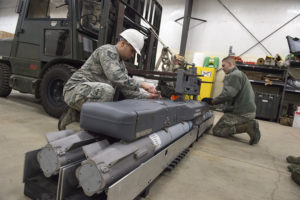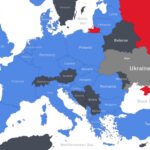
Airmen with the 3rd Munitions Squadron assemble a rack of inert small diameter bombs during readiness training at Joint Base Elmendorf-Richardson, Alaska, Feb. 9, 2018. The small diameter bomb is a precise and accurate weapon that allows the the F-22 Raptor to deliver decisive air power. (U.S. Air Force photo by Alejandro Peña)
As the war in Ukraine heads into its eleventh month (or ninth year if you count the start of the war as 2014), calls are growing to arm Ukraine with longer-range weapons to even the battlefield. In Foreign Policy, Gabriel Collins explains the reasoning behind the push for longer-range weapons for Ukraine, writing:
Ending the war in Ukraine and saving lives requires decisively defeating Russia. But exceedingly difficult decisions lie ahead. Moscow’s campaign of destruction against Ukraine’s energy system weaponizes winter against Ukrainian civilians, seeks to exhaust Ukraine’s air defenses, and sets the stage for a significantly more severe European and global energy crisis in the winter of 2023 and 2024. Russian President Vladimir Putin’s likely goals are to make Ukraine uninhabitable and destabilize European politics through a refugee crisis, break the political will of Ukraine’s military benefactors, and force a cease-fire that allows Russia to retain stolen territory. As a backstop, Russia aims to destroy Ukraine’s infrastructure so thoroughly as to render it an economically failed state ripe for re-invasion after a temporary peace.
Ukraine thus finds itself on the wrong side of a highly consequential law of conflict: The offensive (Russia) has the initiative in altering its strategy and only needs to be right once to inflict massive, potentially existential harm. Kyiv needs a strategic shift in 2023 to save its citizens’ lives and spare the country further destruction by “defending forward,” taking a offensive approach to shield its citizens, but it will be hard pressed to do so without political assent from key NATO parties, especially the United States. The status quo approach favors Russia over time. How, therefore, might American and other NATO decision-makers think about accepting incremental risk in the near term versus deferring a strategy shift decision now and instead accepting future risk?
To start, Russia’s escalatory shift—if successful in retaining seized Ukrainian territories—would very plausibly embolden it for further revisionist actions. This would open pathways to direct NATO-Russia military confrontation that have not yet arisen even in today’s tense environment. Future campaigns of conquest would in many cases leave the United States and its allies with far fewer and much worse options than what they face now. Imagine a future attack on the Suwalki Gap to create a land bridge from Kaliningrad, Russia, to Belarus, for instance.
This means policy decisions on Ukraine must look at today—but with an eye to deterring wars of tomorrow. As recent history shows, any remnant Russian territorial foothold within Ukraine’s 1991 borders will likely become Moscow’s pretext for its next conflict, just as Russia’s seizure of Crimea and parts of the Donbas in 2014 helped set the stage for the current war. For centuries, Moscow has displayed a pattern of seeking “security through conquest.” These actions have, at various times, included expanding into the Baltics, Moldova, Finland, and much of modern Ukraine; participating in several partitions of Poland; conquering much of the Caucasus and Central Asia; and executing multiple takeovers of Crimea—most recently in 2014. Russian political figures may disagree on internal governance, but their relative alignment on territorial expansion in the former Soviet and Russian imperial zones suggests that even significant changes to who runs Russia would not assure neighbors’ security.
Deterring a future war means Ukraine will first need to recapture a nearly Hungary-sized portion of its territory that remains under Russian control. This will likely require main battle tanks, infantry fighting vehicles, lots of artillery, and the ability to interdict Russian troops and supplies 30 miles (and ideally, much farther) behind the front lines. I focus on the last item—long-range precision strike capacity—because Ukraine cannot win without it, and only the United States can both provide it at scale and inspire other alliance partners to join in.
Longer-range precision fires do two key things. First, on the tactical level, they allow Ukraine to expend munitions rather than soldiers and can make Russia’s occupation of the Donbas, Sea of Azov coast, and eventually Crimea untenable. The High Mobility Artillery Rocket System (known as HIMARS) has been critical to date. HIMARS’s lethality would rise to a whole new level if NATO provides the Ground-Launched Small Diameter Bomb system—which offers roughly twice the range of Guided Multiple Launch Rocket System weapons that Ukraine now uses, high accuracy, formidable hard target destruction capabilities, and an existing “ready to go” inventory of thousands of munitions. In short, the Ground-Launched Small Diameter Bomb would turn a HIMARS truck into a poor man’s tactical jet—without the associated vulnerabilities to Russian air defenses.
Second, much longer-range fires could help Ukraine curtail strikes on its battered civilian and industrial infrastructure as well as interdict Russian military regeneration and reinforcement capacities before they reach the battlefield, goals that upgraded air defenses alone cannot achieve. Kyiv now pursues a 1,000-kilometer (or 621-mile) range indigenous drone system, which could target airfields in Belarus and deep into Russia as well as munitions plants, naval bases, fuel storage, military depots, staging areas, and railways. Deep strikes—at an intensity of dozens or more per month—would be a proportional response against Russia’s now monthslong campaign against Kyiv’s industrial base and energy system. They would also erode Russia’s offensive warfare capacity without directly targeting Russian civilians or political leadership, thus advancing military aims while managing escalation potential.
Ukrainian deep strikes aiming to degrade Russia’s offensive military potential would borrow from NATO’s 1980s Follow-On Forces Attack concept. This approach sought to first hold ground and then facilitate battlefield victory by disrupting and destroying follow-on Soviet forces and logistical links up to at least 800 kilometers (or 497 miles) behind the front lines, defending forward to help reduce nuclear escalation risks. A modern higher-intensity Ukrainian deep interdiction campaign would also seek to facilitate battlefield victory while simultaneously being self-defensive. The objective would be a secure peace for both Ukraine and Russia based on restoration of—and respect for—pre-2014 borders. Public and private diplomacy can and should emphasize that point.
Deep interdiction is not by itself a war-ender. But it would turn time and defense burdens against Russia by reducing ammunition availability as well as facilitate Ukraine’s battlefield gains by forcing Russia to choose between allocating air defense resources to protect its military sustainment base or forces on the battlefield. Scalable 1,000-kilometer-range loitering munition production would also give Ukraine the ability to credibly retaliate if Russia began using ballistic missiles imported from Iran to strike targets in Ukraine.
If you’re willing to fight for Main Street America, click here to sign up for the Richardcyoung.com free weekly email.





